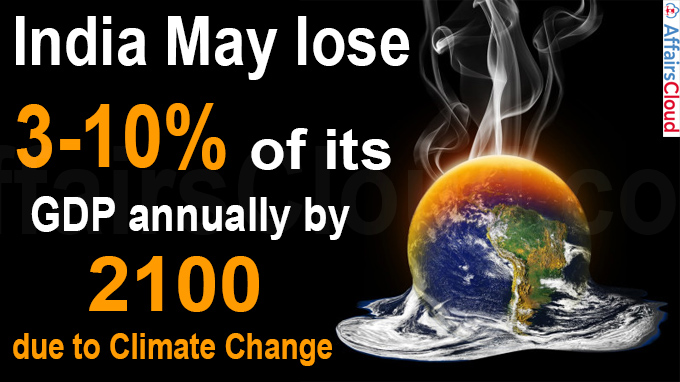 The report ‘The Costs of Climate Change in India: a review of the climate-related risks facing India, and their economic and social costs’ released by the Overseas Development Institute(ODI), a London-based global think tank, stated the possibility for India to lose 3-10 percent of its gross domestic product (GDP) annually by 2100 due to climate change.
The report ‘The Costs of Climate Change in India: a review of the climate-related risks facing India, and their economic and social costs’ released by the Overseas Development Institute(ODI), a London-based global think tank, stated the possibility for India to lose 3-10 percent of its gross domestic product (GDP) annually by 2100 due to climate change.
- It also estimated the poverty rate of India to rise by 3.5 percent in 2040 due to climate change.
Key Analysis of the Report:
i.The report analysed the economic costs of climate-related risks in India and pointed out the possibility of increased inequality and poverty.
ii.India has seen an increase in temperatures of 0.62 degree Celsius over the last 100 years. While the increase is lower than the global average of 1 degree Celsius.
- Despite being home to 17.8 percent of the world’s population, India accounts for only 3.2 percent of cumulative emissions.
iii.Global Warming:
- As per the report, India was currently experiencing the consequences of 1°C of global warming. Flooding in India over the past decade has caused $3-billion in economic damage – accounting for 10 percent of global economic losses from flooding.
iv.Economic Loss:
- If the global temperatures are contained to 2 degrees Celsius by 2100, India will lose 2.6 percent GDP annually and if the global temperature is increased to 4 degrees Celsius, India will lose 13.4 percent GDP annually.
- Climate- induced disappearance of agricultural activity in Ganges-Brahmaputra-Meghna and Mahanadi deltas will lead to an economic loss of 18–32 percent of GDP.
v.Reverse Development:
- India has made rapid progress in boosting incomes and living standards over the last 3 decades but due to lack of rapid global action, climate change, the development gains of recent decades might be reversed.
- Both urban and rural populations will face rising cereal prices with declining wages in the agricultural sector and the slower rate of economic growth due to climate change.
vi.Disease: Climate change with temperature and precipitation changes, may affect labour productivity through increased endemic vector-borne diseases such as malaria, dengue, chikungunya, filariasis, Japanese encephalitis and visceral leishmaniasis.
vii.Rise in inequalities: Inequalities will be increased as the income and wealth levels, gender relations, and caste dynamics intersect with climate change. As climate change is slowing the pace of poverty reduction, it will affect rural parts more than the urban areas.
Note – As per the report, pursuing low-carbon development could stimulate a faster, fairer economic recovery for India.
Recent Related News:
According to the National Climate Vulnerability Assessment report titled ‘Climate Vulnerability Assessment for Adaptation Planning in India Using a Common Framework’ released by the Department of Science & Technology (DST), 8 Eastern States viz, Jharkhand, Mizoram, Odisha, Chhattisgarh, Assam, Bihar, Arunachal Pradesh, and West Bengal have been identified as Highly Vulnerable to Climate Change.
About Overseas Development Institute(ODI):
Headquarters – London, United Kingdom
Chief Executive – Sara Pantuliano




